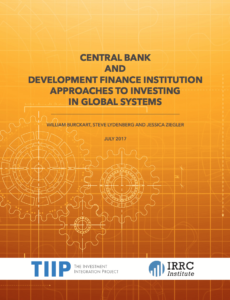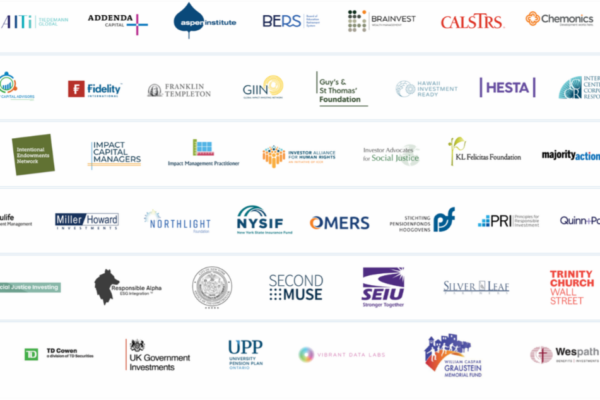NEW YORK, NY, July 25, 2017 – A new report analyzes how and why central banks (CBs) and development finance institutions (DFIs) incorporate environmental, societal, and financial systems-level thinking into their activities. The report identifies five “on ramp” activities that these financial institutions use to address systems-level risks and rewards, and it suggests parallels to how long-term investors attempt to manage systemic risks. Read the press release here.
Central Bank and Development Finance Institution Approaches to Investing in Global Systems analyzes six central banks (including two U.S. Federal Reserve System regional banks), seven DFIs, and one microfinance bank, all of which are known to be incorporating environmental, societal, or financial systems-level considerations into their programs. The report, commissioned by the Investor Responsibility Research Center Institute (IRRCi) and authored by William Burckart, Steve Lydenberg and Jessica Ziegler with The Investment Integration Project (TIIP), suggests that investors could learn from how the CBs and DFIs approach systemic risk issues.

Download the full report here.
The analysis comes at a time when the world is increasingly interconnected, populous, prosperous, and complex, and while institutional investors are increasingly concerned about the interplay between environmental, societal, and financial systems and their investments.
Recent actions and statements by CBs and DFIs indicate that they are incorporating systems level thinking into their work. They contend that concern for systems-level issues aligns closely with CB mandates to stabilize financial systems, catalyze entire economies, set monetary policy, and mange interest rates and money supply, and with DFI missions to generate economic growth and alleviate poverty through investing in the private sector in emerging markets.
A webinar on Thursday, August 17, 2017, at 1 PM ET served to review the findings and respond to questions. See below for a recording of the webinar.
The report finds that CBs and DFIs have incorporated five “on ramp” activities to bring attention to and address systems-level risks and rewards:
- Environmental and social risk assessment. The identification, definition, and quantification of issues that are potential sources of economic instability, social unrest, or environmental disruption.
- Long-term prosperity protection. Focusing on the enduring long-term health of the systems within which they operate, which is vital to protecting lasting prosperity.
- Impact measurement. Specifying, evaluating and reporting on social and environmental factors throughout the investment process along the dimensions of various impact evaluation frameworks.
- Financial systems stewardship. Protecting and enhancing financial systems over the long-term by encouraging behavior that supports the prioritization by investors of positive systems-level societal and environmental considerations in their decision-making.
- Universal cooperation. Consideration of the need for cooperation among nations that they serve in their policies and practices as they build consensus across regions, economies, and countries.
“Sustainable prosperity means different things to different investors. For CBs and DFIs it may mean economic stability and poverty alleviation; for investors it may mean wealth generation and preservation. But the common thread is the need to enhance and safeguard the systems-level sources of this prosperity. While still in its infancy, systems-level investing holds tremendous promise for doing just that in an increasingly interconnected and complex world,” said Jon Lukomnik, IRRCi executive director.
“More and more, institutional investors are recognizing the complicated interplay between global systems and their portfolio decision making. What has been less obvious are the ways in which investors can most effectively go about developing and integrating these considerations into their practices and policies. Though they do not offer direct comparisons, CBs and DFIs do provide compelling insights and lessons for institutional investors looking to embrace a systems-focus,” said William Burckart, report co-author, TIIP president and chief operating officer, and visiting scholar to the Center for Community Development at the Federal Reserve Bank of San Francisco.
This new report is an extension to a previous report, Tipping Points 2016: Summary of 50 Asset Owners and Managers’ Approaches to Investing in Global Systems. This previous study demonstrated that a range of investors are exploring whether and how the health of the environmental, societal and financial systems within which they operate impact their portfolios and vice versa.
The Investment Integration Project conducts research and analysis that enables institutional investors to make the important connection between their portfolio-level decisions and environmental, societal, and financial systems-level considerations. TIIP’s research portal and database of investor profiles, market analysis, and practical guidance provides a way to better match investors to like-minded peers, benchmark strategies, and optimize the development of investment activities and other initiatives that address pressing systems-level issues. More information is available at https://tiiproject.com/
The Investor Responsibility Research Center Institute is a nonprofit research organization that funds academic and practitioner research enabling investors, policymakers, and other stakeholders to make data-driven decisions. IRRCi research covers a wide range of topics of interest to investors, is objective, unbiased, and disseminated widely. More information is available at www.irrcinstitute.org.
Media Contacts:
William Burckart |+1.646.902.4511| [email protected] | @TIIP_Insights
Kelly Kenneally | +1.202.256.1445 | [email protected] | @irrcresearch


